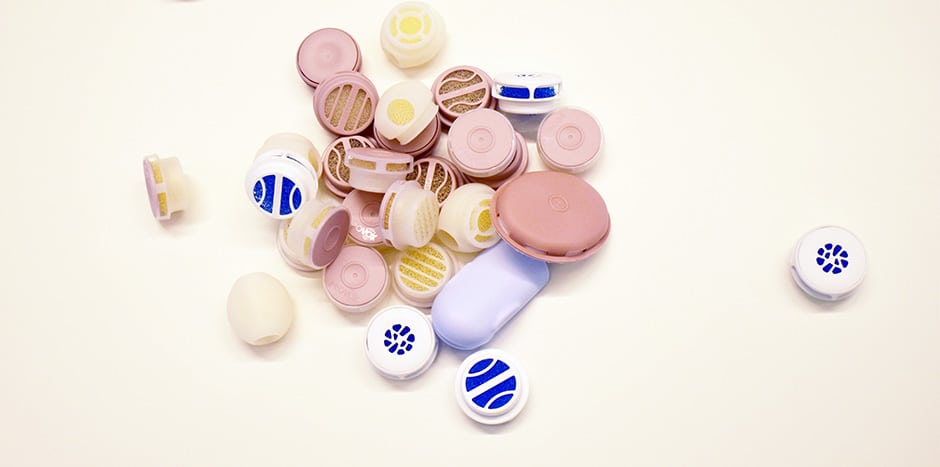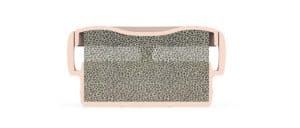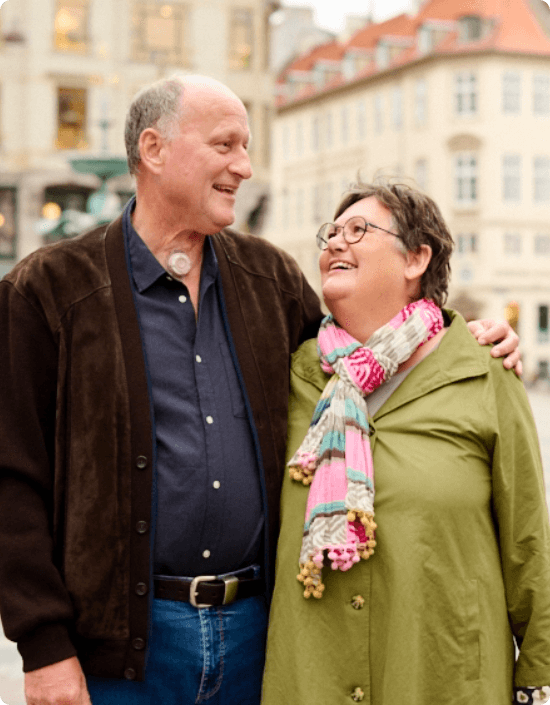Articles & Blog posts
Easy access
Make sure you can always access your favourite content by connecting My Content to your email.
Connect my emailAlready connected?
If you have already connected My Content to your email all you need to do is verify your email.
Verify my email08 February 2022
What is an HME and why would you need to wear one?
If your doctor hasn’t already talked to you about an HME, make sure to ask them for information.

By now you have most certainly come across the term HME. But you may not be entirely sure what it is. Firstly, HME stands for Heat and Moisture Exchanger and this is exactly how it operates. Since you no longer have the humidifying and filtering functions of your nose, an HME can be considered your new “nose”. It will mimic the functions of your nose and ensure that the air entering and exiting your lungs is heated and humidified, making sure the climate of your lungs is balanced.

If you were to not wear an HME, you would breathe air through the open stoma in your neck and the air that reaches your lungs will be cooler and less humid than it should be. Your lungs will react by producing more mucus, and your windpipe can feel irritated. This can cause you to cough a lot. But wearing an HME can help you reduce coughing and mucus as well as help you breathe better.
How does an HME function?
You will place an HME over the stoma in your neck. As you breathe through it, the air is heated and made moister. It does this by catching the heat and humidity of exhaled air and then transferring it to the air you inhale.

HME benefits include
- Enables speaking after a total laryngectomy
- Enables occlusion of the stoma
- Conditioning of the inhaled air
- Improves voice
- Protects your stoma and airways
Download a helpful list for your appointment
Click hereAn HME for all occasions
Using the best HME for certain situations can help improve your lung health. There is a range of HMEs that balance humidification and breathability according to the situation.

Whether you are relaxing in the comfort of your own home, going out for a light stroll, hopping on a mountain bike, requiring protection during flu season, or even sleeping, there is an HME that suits the situation.
Using an HME 24 hours a day
The benefits of using an HME are substantial when compared to not wearing an HME at all. However, to improve your lung health and feel the difference of using HMEs, it is best to wear them all the time. Day and night.
The benefits of adherent HME use are backed by clinical studies involving laryngectomized people. The studies showed that:
- Coughing significantly decreased after 12 weeks of adherent HME use
- Respiratory symptoms such as coughing and excess mucus significantly decreased after 2 weeks of adherent HME use
So, the benefits of wearing an HME and wearing an HME in different situations throughout the day are apparent. Adjusting to using an HME can be challenging in the beginning and you may notice a temporary increase in coughing and mucus, but with continuous use, you will start to notice the benefits.
- van den Boer C, Nuller SH, Vincent AD, van den Brekel MW, Hilgers FJ. Ex vivo assessment and validation of water exchange performance of 23 heat and moisture exchangers for laryngectomized patients. Respir Care. 2014;59(8):1161-71.
- Lansaat L, Boer CV, Muller SH, Noort VV, Brekel MW, Hilgers FJ. Ex vivo humidifying capacity and patient acceptability of stoma cloths in laryngectomized individuals. Head Neck. 2017;39(5):921-31.
- van den Boer C, Muller SH, Vincent AD, Zuchner K, van den Brekel MW, Hilgers FJ. Ex vivo water exchange performance and short-term clinical feasibility assessment of newly developed heat and moisture exchangers for pulmonary rehabilitation after total laryngectomy. Eur Arch Otorhinolaryngol. 2014;271(2):359-66.
- van den Boer C, Vas Nunes JH, Muller SH, van dN, V, van den Brekel MW, Hilgers FJ. Water Uptake Performance of Hygroscopic Heat and Moisture Exchangers after 24-Hour Tracheostoma Application. Otolaryngol Head Neck Surg. 2014;150(6):999-1004.
- Zuur JK, Muller SH, de Jongh FH, Van ZN, Hilgers FJ. The physiological rationale of heat and moisture exchangers in post-laryngectomy pulmonary rehabilitation: a review. Eur Arch Otorhinolaryngol. 2006;263(1):1-8.
- Harris S, Jonson B. Lung function before and after laryngectomy. Acta Otolaryngol. 1974;78(3-4):287-94.
- Natvig K. Influence of different climates on the peak expiratory flow in laryngectomees. J Laryngol Otol. 1984;98(1):53-8.
- Todisco T, Maurizi M, Paludetti G, Dottorini M, Merante F. Laryngeal cancer: long-term follow-up of respiratory functions after laryngectomy. Respiration. 1984;45(3):303-15.
- Togawa K, Konno A, Hoshino T. A physiologic study on respiratory handicap of the laryngectomized. Arch Otorhinolaryngol. 1980;229(1):69-79.
- Torjussen W. Airway obstructions in laryngectomized patients. A spirometric investigation. Acta Otolaryngol. 1968;66(1):161-70.
- Hilgers FJ, Ackerstaff AH, Aaronson NK, Schouwenburg PF, Van Zandwijk N. Physical and psychosocial consequences of total laryngectomy. Clin Otolaryngol Allied Sci. 1990;15(5):421-5.
- Usui N. Ventilatory function in laryngectomized patients. Auris Nasus Larynx. 1979;6(2):87-96.
- Herranz J, Espino MA, Morado CO. Pulmonary rehabilitation after total laryngectomy: a randomized cross-over clinical trial comparing two different heat and moisture exchangers (HMEs). Eur Arch Otorhinolaryngol. 2013;270(9):2479-84.
- Parrilla C, Minni A, Bogaardt H, Macri GF, Battista M, Roukos R, et al. Pulmonary Rehabilitation After Total Laryngectomy: A Multicenter Time-Series Clinical Trial Evaluating the Provox XtraHME in HME-Naive Patients. Ann Otol Rhinol Laryngol. 2015;124(9):706-13.
- Macri GF, Bogaardt H, Parrilla C, Minni A, D’Alatri L, de Vincentiis M, et al. Patients’ experiences with HMEs and attachments after total laryngectomy. Clin Otolaryngol. 2016;41(6):652-9.
- Kligerman MP, Vukkadala N, Tsang RKY, Sunwoo JB, Holsinger FC, Chan JYK, et al. Managing head and neck cancer patients with tracheostomy or laryngectomy during the COVID-19 pandemic. Head Neck. 2020.
- Scheenstra RJ, Muller SH, Vincent A, Ackerstaff AH, Jacobi I, Hilgers FJ. Short-term endotracheal climate changes and clinical effects of a heat and moisture exchanger with an integrated electrostatic virus and bacterial filter developed for laryngectomized individuals. Acta Otolaryngol. 2010;130(6):739-46.
- Scheenstra RJ, Muller SH, Vincent A, Hilgers FJ. Heat and moisture exchange capacity of the upper respiratory tract and the effect of tracheotomy breathing on endotracheal climate. Head Neck. 2011;33(1):117-24.
- Ackerstaff AH, Hilgers FJ, Aaronson NK, De Boer MF, Meeuwis CA, Knegt PP, et al. Heat and moisture exchangers as a treatment option in the post-operative rehabilitation of laryngectomized patients. Clin Otolaryngol Allied Sci. 1995;20(6):504-9.
- Ackerstaff AH, Hilgers FJ, Aaronson NK, Balm AJ, Van ZN. Improvements in respiratory and psychosocial functioning following total laryngectomy by the use of a heat and moisture exchanger. Ann Otol Rhinol Laryngol. 1993;102(11):878-83.
- Hilgers FJ, Aaronson NK, Ackerstaff AH, Schouwenburg PF, van ZN. The influence of a heat and moisture exchanger (HME) on the respiratory symptoms after total laryngectomy. Clin Otolaryngol Allied Sci. 1991;16(2):152-6.
- Ackerstaff AH, Hilgers FJ, Balm AJ, Tan IB. Long-term compliance of laryngectomized patients with a specialized pulmonary rehabilitation device: Provox Stomafilter. Laryngoscope. 1998;108(2):257-60.
Sign up to get a free list with information about what questions your doctor might ask you.


